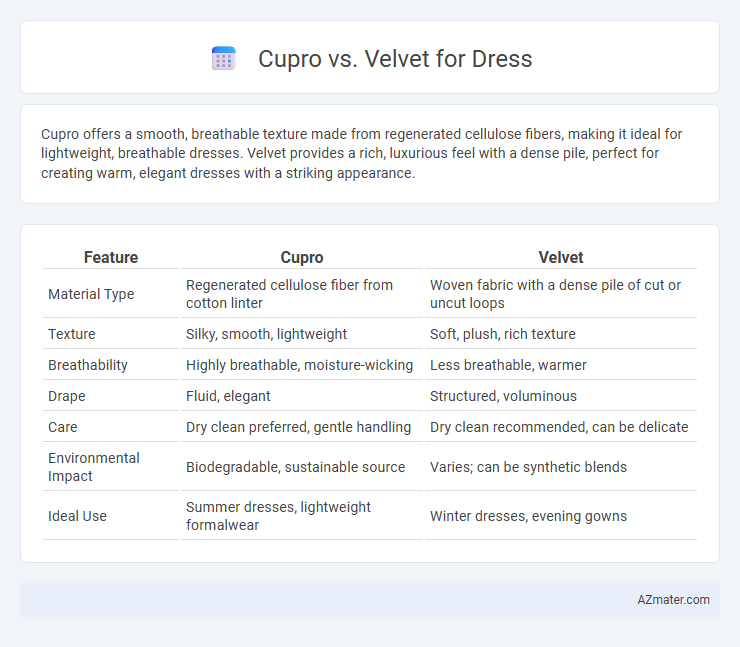Cupro offers a smooth, breathable texture made from regenerated cellulose fibers, making it ideal for lightweight, breathable dresses. Velvet provides a rich, luxurious feel with a dense pile, perfect for creating warm, elegant dresses with a striking appearance.
Table of Comparison
| Feature | Cupro | Velvet |
|---|---|---|
| Material Type | Regenerated cellulose fiber from cotton linter | Woven fabric with a dense pile of cut or uncut loops |
| Texture | Silky, smooth, lightweight | Soft, plush, rich texture |
| Breathability | Highly breathable, moisture-wicking | Less breathable, warmer |
| Drape | Fluid, elegant | Structured, voluminous |
| Care | Dry clean preferred, gentle handling | Dry clean recommended, can be delicate |
| Environmental Impact | Biodegradable, sustainable source | Varies; can be synthetic blends |
| Ideal Use | Summer dresses, lightweight formalwear | Winter dresses, evening gowns |
Introduction to Cupro and Velvet Fabrics
Cupro fabric, derived from regenerated cellulose fibers made from cotton linter, offers a silky texture, breathability, and excellent drape, making it ideal for elegant dress designs. Velvet, a luxurious textile characterized by its dense pile weave, provides a rich, soft feel with a distinctive shimmer, often used for opulent and formal dresses. Both fabrics vary in weight and appearance, influencing the garment's comfort, warmth, and visual appeal.
What is Cupro? Material Overview
Cupro is a regenerated cellulose fiber derived from cotton linter, known for its silky texture and breathability, making it an excellent choice for lightweight, comfortable dresses. Unlike velvet, which is a plush fabric made from woven tufted fibers, cupro offers a smooth, satin-like finish with moisture-wicking properties ideal for warm weather wear. Its eco-friendly production process and biodegradability add to its appeal as a sustainable alternative in high-end fashion textiles.
What is Velvet? Material Overview
Velvet is a luxurious fabric characterized by its dense pile of evenly cut fibers that create a soft, smooth texture and a distinctive sheen, traditionally made from silk but now commonly produced with polyester, nylon, or rayon blends. It offers excellent drape, warmth, and a rich appearance, making it a popular choice for elegant dresses and evening wear. The material's plush surface and weight give velvet a high-end look, suitable for formal occasions and winter attire.
Texture and Appearance: Cupro vs Velvet
Cupro fabric features a smooth, silky texture with a subtle sheen that enhances its lightweight and breathable qualities, making it ideal for flowy dresses. Velvet offers a plush, dense pile with a rich, luxurious appearance that adds depth and warmth, suitable for elegant and winter dresses. While Cupro emphasizes a sleek, matte finish, Velvet showcases a soft, vibrant surface that shifts color with light, creating a dramatic visual impact.
Breathability and Comfort Comparison
Cupro fabric offers exceptional breathability due to its natural cellulose fibers derived from cotton linter, making it ideal for dresses worn in warm climates as it effectively wicks moisture and allows air circulation. Velvet, typically woven from silk, cotton, or synthetic fibers, tends to trap heat and provides less ventilation, which may reduce comfort in hotter conditions. For dress comfort, cupro's smooth, lightweight texture feels soft on the skin while velvet's plush pile delivers a luxurious but heavier and warmer sensation that may be less suitable for extended wear in humid environments.
Durability and Care: Maintenance Insights
Cupro fabric offers moderate durability with a smooth, silk-like feel but requires delicate care, including hand washing or gentle machine cycles to maintain its integrity. Velvet, known for its plush texture and heavyweight composition, provides higher durability and resists wear better, yet demands special attention to avoid crushing the pile, often needing professional cleaning. Both materials benefit from proper storage and minimal exposure to moisture to preserve their texture and appearance over time.
Eco-Friendliness and Sustainability Factors
Cupro, a regenerated cellulose fiber derived from cotton linter, offers superior eco-friendliness due to its biodegradable nature and closed-loop production process that recycles chemicals and water. Velvet, typically made from silk, cotton, or synthetic fibers, varies in sustainability; silk velvet has natural biodegradability but high resource consumption, while synthetic velvet involves petrochemicals and lower biodegradability. Choosing cupro for dresses aligns better with sustainable fashion goals, reducing environmental impact through renewable materials and eco-conscious manufacturing practices.
Versatility in Dress Design and Style
Cupro and velvet each bring unique versatility to dress design; Cupro offers a smooth, breathable fabric that drapes elegantly, making it ideal for flowing and structured silhouettes alike. Velvet's rich texture and sheen provide depth and luxury, perfect for formal and evening wear, while its weight supports structured designs and layered styles. Designers often choose Cupro for lightweight, breathable dresses suitable for warm climates, whereas velvet excels in creating dramatic, statement pieces with a sophisticated finish.
Cost and Accessibility: Cupro vs Velvet
Cupro fabric is generally more affordable and widely accessible due to its cellulose-based origins and easier production compared to velvet, which tends to be pricier because of its intricate weaving process and luxurious texture. Velvet, often made from silk, cotton, or synthetic fibers, carries a higher cost tied to its rich aesthetic and durability, making it less accessible for everyday wear. Both materials are available in various qualities, but cupro stands out for budget-friendly options that do not compromise on the smooth, breathable characteristics desirable in dresses.
Which Fabric is Best for Your Next Dress?
Cupro fabric, made from regenerated cellulose fibers, offers a silky smooth texture and excellent breathability, making it ideal for lightweight, breathable dresses that drape gracefully. Velvet, characterized by its dense pile and luxurious sheen, provides a rich, plush appearance suitable for formal or evening wear but may feel heavier and warmer. Choosing between cupro and velvet depends on the occasion and climate, with cupro favored for comfort and versatility, while velvet excels in elegance and warmth.

Infographic: Cupro vs Velvet for Dress
 azmater.com
azmater.com